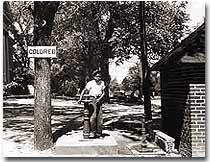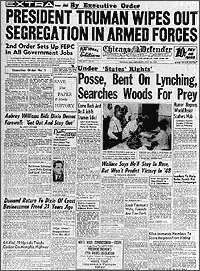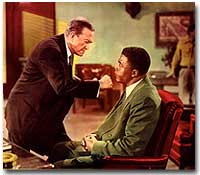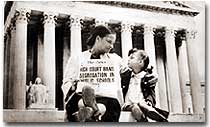54a. Separate No Longer?

Jim Crow laws existed in several southern states and served to reinforce the white authority that had been lost following Reconstruction. One such law required blacks and whites to drink from separate water fountains.
During the first half of the 20th century, the United States existed as two nations in one.
The Supreme Court ruling in Plessy v. Ferguson (1896) decreed that the legislation of two separate societies — one black and one white — was permitted as long as the two were equal.
States across the North and South passed laws creating schools and public facilities for each race. These regulations, known as Jim Crow laws, reestablished white authority after it had diminished during the Reconstruction era. Across the land, blacks and whites dined at separate restaurants, bathed in separate swimming pools, and drank from separate water fountains.

The July 31, 1948, edition of the Chicago Defender announces President Truman's executive order ending segregation in the U.S. armed forces.
The United States had established an American brand of apartheid.
In the aftermath of World War II, America sought to demonstrate to the world the merit of free democracies over communist dictatorships. But its segregation system exposed fundamental hypocrisy. Change began brewing in the late 1940s. President Harry Truman ordered the end of segregation in the armed services, and Jackie Robinson became the first African American to play Major League Baseball. But the wall built by Jim Crow legislation seemed insurmountable.
The first major battleground was in the schools. It was very clear by mid-century that southern states had expertly enacted separate educational systems. These schools, however, were never equal. The National Association for the Advancement of Colored People (NAACP), led by attorney Thurgood Marshall, sued public schools across the South, insisting that the "separate but equal" clause had been violated.

In the summer of 1947, Jackie Robinson became the first African American to play major league baseball. After a stellar career, he became the first African American player elected to the Baseball Hall of Fame.
In no state where distinct racial education laws existed was there equality in public spending. Teachers in white schools were paid better wages, school buildings for white students were maintained more carefully, and funds for educational materials flowed more liberally into white schools. States normally spent 10 to 20 times on the education of white students as they spent on African American students.
The Supreme Court finally decided to rule on this subject in 1954 in the landmark Brown v. Board of Education of Topeka case.
The verdict was unanimous against segregation. "Separate facilities are inherently unequal," read Chief Justice Earl Warren's opinion. Warren worked tirelessly to achieve a 9-0 ruling. He feared any dissent might provide a legal argument for the forces against integration. The united Supreme Court sent a clear message: schools had to integrate.

May 17, 1954, saw the Supreme Court — in the case of Brown v. Board of Education of Topeka — rule that segregation of public schools was a violation of the Fourteenth Amendment, which states that all citizens deserve equal protection under the law.
The North and the border states quickly complied with the ruling, but the Brown decision fell on deaf ears in the South. The Court had stopped short of insisting on immediate integration, instead asking local governments to proceed "with all deliberate speed" in complying.
Ten years after Brown, fewer than ten percent of Southern public schools had integrated. Some areas achieved a zero percent compliance rate. The ruling did not address separate restrooms, bus seats, or hotel rooms, so Jim Crow laws remained intact. But cautious first steps toward an equal society had been taken.
It would take a decade of protest, legislation, and bloodshed before America neared a truer equality.






